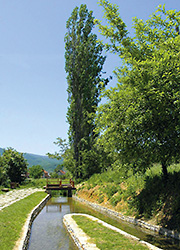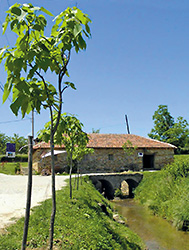Mark
IN LOWER NERODIMLJE NEAR UROŠEVAC, IN THE SOUTHERN SERBIAN PROVINCE, A NATURAL PHENOMENON
One River into Two Seas
The scientists call this bifurcation. At the place where there used to be one of the royal seats of the medieval Nemanjić dynasty, the Nerodimka River branches out. One of its branches flows toward the Sitnica and Ibar, all the way to the Black Sea, and the other branch to the Lepenac, Vardar and Aegean Sea. This is also accounted for in the Charter of Gračanica of King Milutin from 1321. Just like the Nerodimka, the Casiquiare River in does the same thing and empties in both the Caribbean Sea and the Atlantic Ocean on the level of the Equator
Text and photographs: Zoran Vlašković
 Near the Nerodimka River, in Upper and Lower Nerodimlje, in big and, before the exodus, fully Serbian villages, four kilometers to the west from Uroševac, there are many natural curiosities and historical sites. Lower Nerodimlje is the best known for a natural rarity, of which there are only two in the world: branching out of a river and its emptying into two seas. Bifurcation, as the scientists call it. In Lower Nerodimlje, the Nerodimka branches out into two rivers, toward the Black and the Aegean Sea. This phenomenon is mentioned in the Charter of Gračanica of King Milutin from 1321. Near the Nerodimka River, in Upper and Lower Nerodimlje, in big and, before the exodus, fully Serbian villages, four kilometers to the west from Uroševac, there are many natural curiosities and historical sites. Lower Nerodimlje is the best known for a natural rarity, of which there are only two in the world: branching out of a river and its emptying into two seas. Bifurcation, as the scientists call it. In Lower Nerodimlje, the Nerodimka branches out into two rivers, toward the Black and the Aegean Sea. This phenomenon is mentioned in the Charter of Gračanica of King Milutin from 1321.
Experts claim that, besides the Nerodimka, such bifurcation – branching out of a river into two smaller ones and its emptying into two seas – exists only in Brazil. The Casiquiare Riverwith one of its branches empties into Orinoco and further into the Caribbean Sea. Its ot her branch flows to Rio Negro, left tributary of the Amazon, one of the two biggest rivers in the world, which empties into the Atlantic Ocean on the level of the Equator. her branch flows to Rio Negro, left tributary of the Amazon, one of the two biggest rivers in the world, which empties into the Atlantic Ocean on the level of the Equator.
From its spring on Drmanska glava, in the northern part of the Nerodimska Mountain on Šara, up to its branching in Lower Nerodimlje, the Nerodimka flows for nine kilometers. There it branches out and with its left branch it empties into the Salizlijo River, and later on to the Sitnica, Ibar, Morava, Danube and the Black Sea. The right branch of this mountain river goes to the Lepenac, then Vardar and the Aegean Sea. The mountain ridges above the spring of the Nerodimka, experts say, distribute water to all three basins in Serbia: toward the Black Sea, Adriatic Sea and Aegean Sea.
ROAD SIGNS THROUGH TIME
 Around the upstream course of the Nerodimka, in the Middle Ages, one of the royal seats of Serbia was created, with the court in Nerodimlje. This seat was defended by fortifications called Big and Small Petrič. Around the upstream course of the Nerodimka, in the Middle Ages, one of the royal seats of Serbia was created, with the court in Nerodimlje. This seat was defended by fortifications called Big and Small Petrič.
A few years ago, with the funds from the European Union, the Nerodimka riverbed was embanked, thirty meters before and thirty meters after the branching. The access and the riverbed itself are no longer muddy.
The point of bifurcation is situated cozily in lush vegetation of green pastures and forests. You can hear the humming of bees and singing of birds. About fifteen kilometers o the south, in straight line, Ljuboten on the Šara dominates, with its 2,498 meters above the sea level. Snowcapped peaks and numerous valleys interspersed with snoweven in late May, indicate one of the possible interpretation of the name of Šar Mountain (šarati = to scribble).
 Only about twenty meters from the point of branching of the Nerodimka there is a big mill, believed to be 600 years old. Four millstones are still grinding cereal even today, and they are driven by the Aegean branch of the Nerodimka, the one that empties into the Lepenac and Vardar. The old mil has been for centuries grinding cereals from the fertile fields of Kosovo and Metohija. The left branch of the Nerodimka, the one toward the Sitnica, flows through the plains and is mostly used for watering of gardens and meadows. Only about twenty meters from the point of branching of the Nerodimka there is a big mill, believed to be 600 years old. Four millstones are still grinding cereal even today, and they are driven by the Aegean branch of the Nerodimka, the one that empties into the Lepenac and Vardar. The old mil has been for centuries grinding cereals from the fertile fields of Kosovo and Metohija. The left branch of the Nerodimka, the one toward the Sitnica, flows through the plains and is mostly used for watering of gardens and meadows.
The bifurcation of the Nerodimka, as a natural rarity, is very attractive for study and tourist visits. Since 1979, it has been protected by the law of Serbia as a special natural reservation, on the surface area of 12.7 hectares. In the centre of Uroševac there are several road signs that point toward this interesting place. It still has to wait for more numerous visits from Central Serbia. But, the day will come. It has always been arriving in the history, and it will do so this time.
***
Lives and Deaths on the Court
Nerodimlje used to be an unfortified court complex of Serbian rulers of the Nemanjić dynasty in the first half of the 14th century. In 1321, king Milutin died there (reigned 1282–1321). It was there that Prince Dušan, the future Serbian Emperor, suddenly besieged Milutin’s son and his own father Stefan (Dečanski). Stefan withdrew to Petrič fortification above Nerodimlje, where he was captured and taken to the city of Zvečan. In this captivity he died, under mysterious circumstances, on November 11, 1331.
***
It Is Necessary to Restore a Lot
Accounts say that Dušan Nemanjić, called ”The Mighty”, the ”emperor of Serbs, Greeks and Albanians”, personally planted a pine tree in Nerodimlje in 1336. In June 1999, when the Southern Serbian province was transferred under the protectorate of the United Nations, that pine tree was cut by the Albanians. It was 663 years old and was officially protected as a natural monument. Since 1999, the Albanians destroyed and burned to the ground all Serbian churches and monasteries in Lower and Upper Nerodimlje. When the Serbian state establishes again the legal and constitutional social order in its southern province, a lot will have to be restored.
|
